Hyundai Accent 2003 Manual PDF
Manufacturer: HYUNDAI, Model Year: 2003, Model line: Accent, Model: Hyundai Accent 2003Pages: 186, PDF Size: 11.36 MB
Page 71 of 186
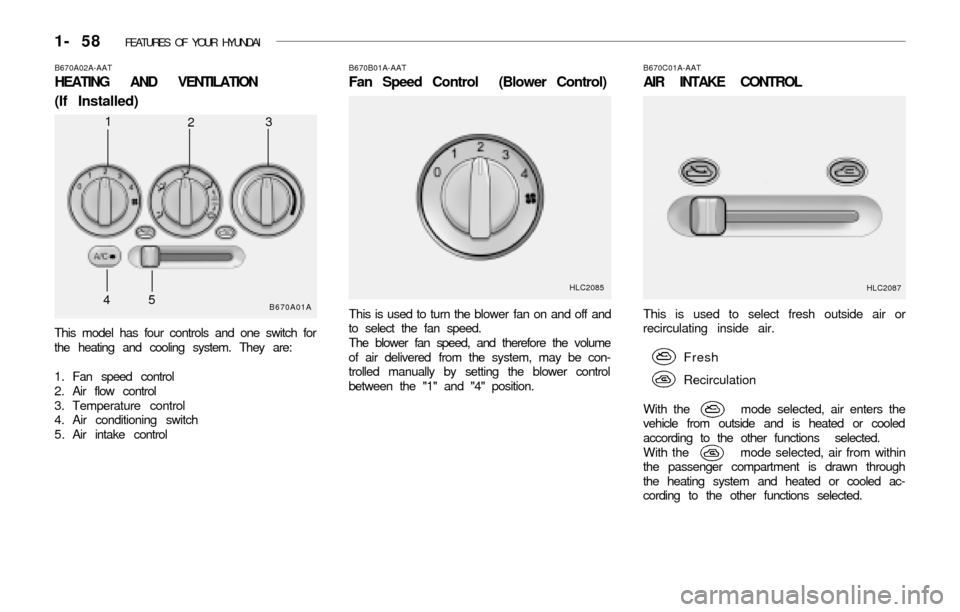
1- 58 FEATURES OF YOUR HYUNDAI
This is used to select fresh outside air or
recirculating inside air.
Fresh
Recirculation
With the mode selected, air enters the
vehicle from outside and is heated or cooled
according to the other functions selected.
With the mode selected, air from within
the passenger compartment is drawn through
the heating system and heated or cooled ac-
cording to the other functions selected.
B670C01A-AAT
AIR INTAKE CONTROL
This model has four controls and one switch for
the heating and cooling system. They are:
1. Fan speed control
2. Air flow control
3. Temperature control
4. Air conditioning switch
5 . Air intake control
B670B01A-AAT
Fan Speed Control (Blower Control)
This is used to turn the blower fan on and off and
to select the fan speed.
The blower fan speed, and therefore the volume
of air delivered from the system, may be con-
trolled manually by setting the blower control
between the "1" and "4" position.
B670A02A-AAT
HEATING AND VENTILATION
(If Installed)
B670A01A
1
23
4
HLC2085HLC20875
Page 72 of 186
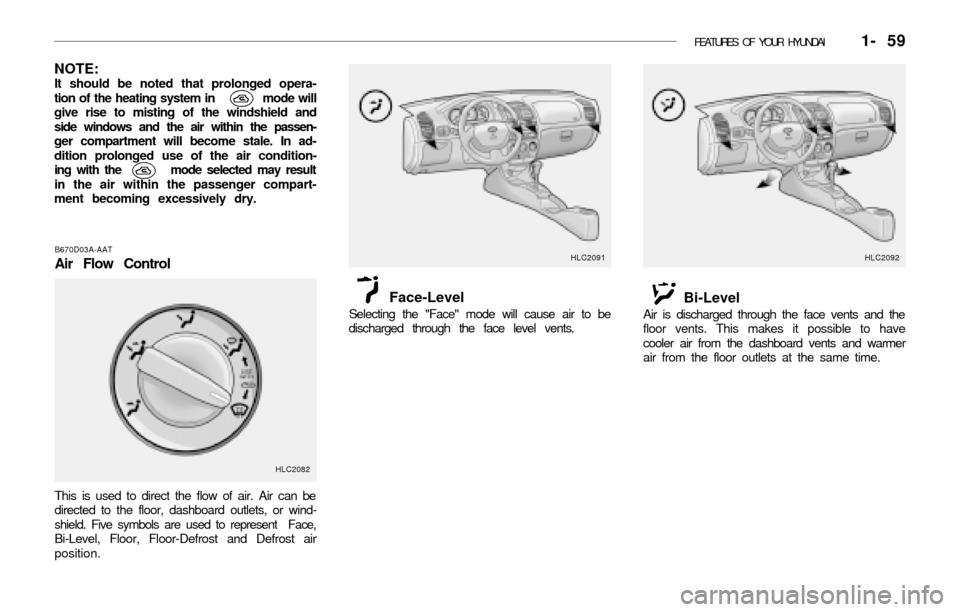
FEATURES OF YOUR HYUNDAI 1- 59
NOTE:It should be noted that prolonged opera-
tion of the heating system in mode will
give rise to misting of the windshield and
side windows and the air within the passen-
ger compartment will become stale. In ad-
dition prolonged use of the air condition-
ing with the mode selected may result
in the air within the passenger compart-
ment becoming excessively dry.
Bi-Level
Air is discharged through the face vents and the
floor vents. This makes it possible to have
cooler air from the dashboard vents and warmer
air from the floor outlets at the same time.
HLC2092HLC2091
Face-Level
Selecting the "Face" mode will cause air to be
discharged through the face level vents.
B670D03A-AAT
Air Flow Control
This is used to direct the flow of air. Air can be
directed to the floor, dashboard outlets, or wind-
shield. Five symbols are used to represent Face,
Bi-Level, Floor, Floor-Defrost and Defrost air
position.
HLC2082
Page 73 of 186
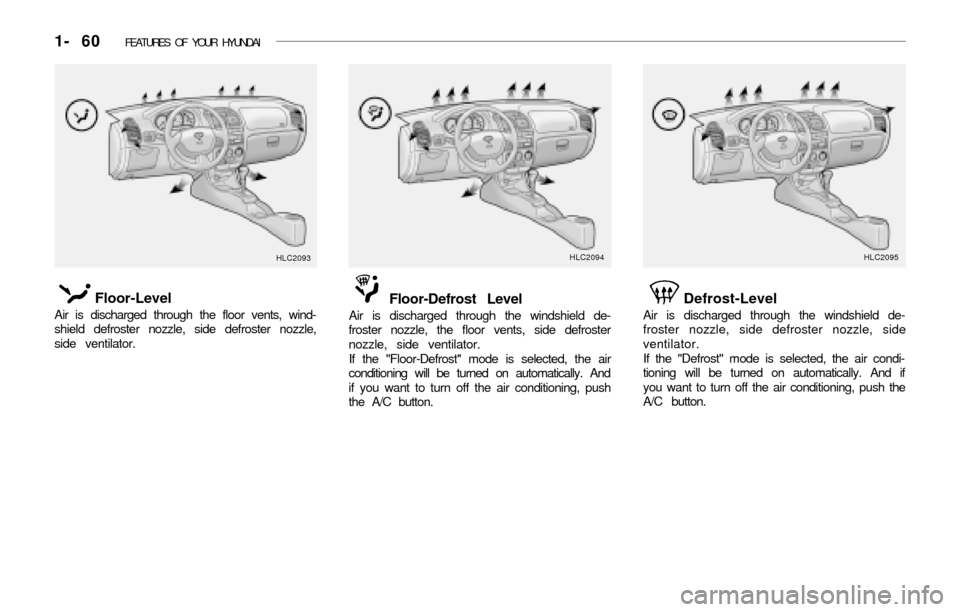
1- 60 FEATURES OF YOUR HYUNDAI
Defrost-Level
Air is discharged through the windshield de-
froster nozzle, side defroster nozzle, side
ventilator.
If the "Defrost" mode is selected, the air condi-
tioning will be turned on automatically. And if
you want to turn off the air conditioning, push the
A/C button.
HLC2095
Floor-Level
Air is discharged through the floor vents, wind-
shield defroster nozzle, side defroster nozzle,
side ventilator.
HLC2093
Floor-Defrost Level
Air is discharged through the windshield de-
froster nozzle, the floor vents, side defroster
nozzle, side ventilator.
If the "Floor-Defrost" mode is selected, the air
conditioning will be turned on automatically. And
if you want to turn off the air conditioning, push
the A/C button.
HLC2094
Page 74 of 186
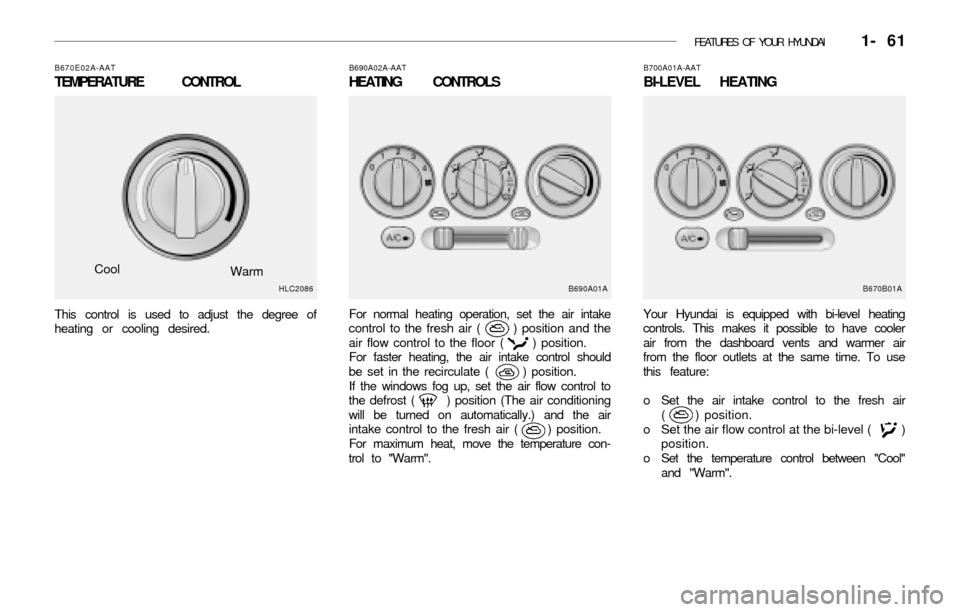
FEATURES OF YOUR HYUNDAI 1- 61
B690A02A-AAT
HEATING CONTROLS
B670E02A-AAT
TEMPERATURE CONTROL
Cool
Warm
This control is used to adjust the degree of
heating or cooling desired.
HLC2086
For normal heating operation, set the air intake
control to the fresh air ( ) position and the
air flow control to the floor ( ) position.
For faster heating, the air intake control should
be set in the recirculate ( ) position.
If the windows fog up, set the air flow control to
the defrost ( ) position (The air conditioning
will be turned on automatically.) and the air
intake control to the fresh air ( ) position.
For maximum heat, move the temperature con-
trol to "Warm".
B700A01A-AAT
BI-LEVEL HEATING
Your Hyundai is equipped with bi-level heating
controls. This makes it possible to have cooler
air from the dashboard vents and warmer air
from the floor outlets at the same time. To use
this feature:
o Set the air intake control to the fresh air
( ) position.
o Set the air flow control at the bi-level ( )
position.
o Set the temperature control between "Cool"
and "Warm".
B690A01AB670B01A
Page 75 of 186
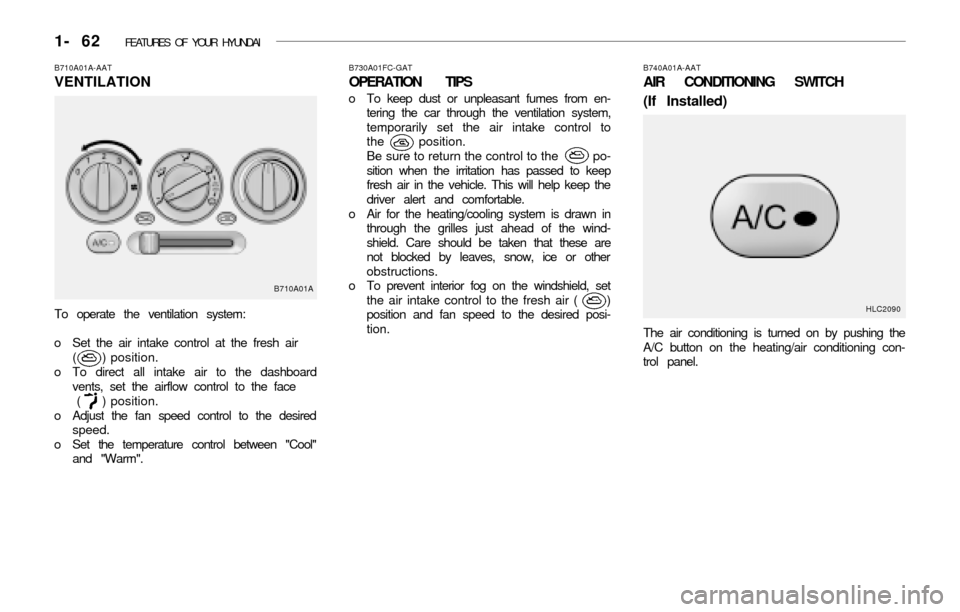
1- 62 FEATURES OF YOUR HYUNDAI
B730A01FC-GAT
OPERATION TIPS
o To keep dust or unpleasant fumes from en-
tering the car through the ventilation system,
temporarily set the air intake control to
the position.
Be sure to return the control to the po-
sition when the irritation has passed to keep
fresh air in the vehicle. This will help keep the
driver alert and comfortable.
o Air for the heating/cooling system is drawn in
through the grilles just ahead of the wind-
shield. Care should be taken that these are
not blocked by leaves, snow, ice or other
obstructions.
o To prevent interior fog on the windshield, set
the air intake control to the fresh air ( )
position and fan speed to the desired posi-
tion.
B740A01A-AAT
AIR CONDITIONING SWITCH
(If Installed)
The air conditioning is turned on by pushing the
A/C button on the heating/air conditioning con-
trol panel.
B710A01A-AAT
VENTILATION
To operate the ventilation system:
o Set the air intake control at the fresh air
( ) position.
o To direct all intake air to the dashboard
vents, set the airflow control to the face
( ) position.
o Adjust the fan speed control to the desired
speed.
o Set the temperature control between "Cool"
and "Warm".
B710A01A
HLC2090
Page 76 of 186
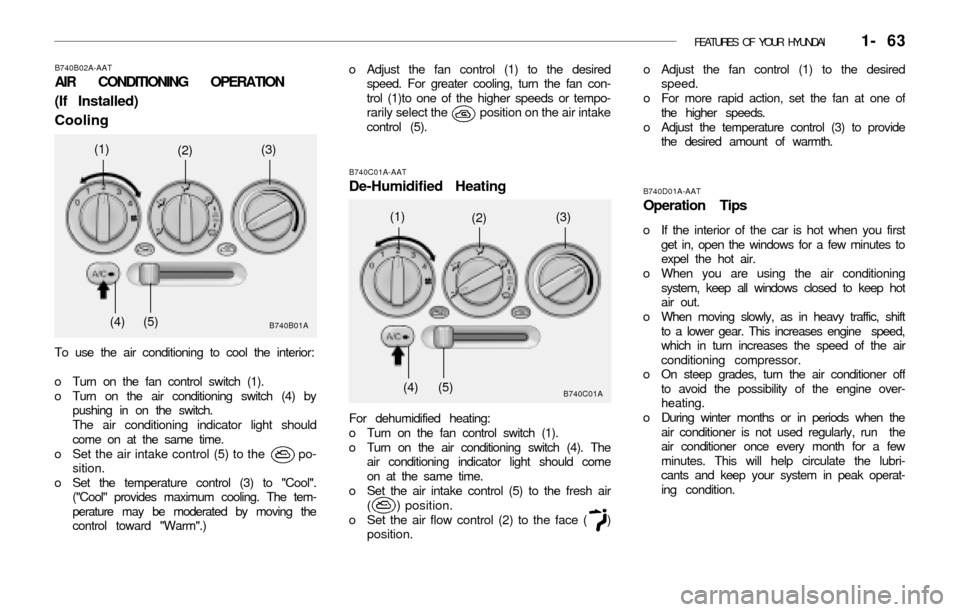
FEATURES OF YOUR HYUNDAI 1- 63
B740B02A-AAT
AIR CONDITIONING OPERATION
(If Installed)
Cooling
To use the air conditioning to cool the interior:
o Turn on the fan control switch (1).
o Turn on the air conditioning switch (4) by
pushing in on the switch.
The air conditioning indicator light should
come on at the same time.
o Set the air intake control (5) to the po-
sition.
o Set the temperature control (3) to "Cool".
("Cool" provides maximum cooling. The tem-
perature may be moderated by moving the
control toward "Warm".)
B740B01A
(1)(2)(3)
(4) (5)
B740D01A-AAT
Operation Tips
o If the interior of the car is hot when you first
get in, open the windows for a few minutes to
expel the hot air.
o When you are using the air conditioning
system, keep all windows closed to keep hot
air out.
o When moving slowly, as in heavy traffic, shift
to a lower gear. This increases engine speed,
which in turn increases the speed of the air
conditioning compressor.
o On steep grades, turn the air conditioner off
to avoid the possibility of the engine over-
heating.
o During winter months or in periods when the
air conditioner is not used regularly, run the
air conditioner once every month for a few
minutes. This will help circulate the lubri-
cants and keep your system in peak operat-
ing condition.
B740C01A-AAT
De-Humidified Heating
For dehumidified heating:
o Turn on the fan control switch (1).
o Turn on the air conditioning switch (4). The
air conditioning indicator light should come
on at the same time.
o Set the air intake control (5) to the fresh air
( ) position.
o Set the air flow control (2) to the face ( )
position.
B740C01A
(1)(2)(3)
(4) (5)
o Adjust the fan control (1) to the desired
speed. For greater cooling, turn the fan con-
trol (1)to one of the higher speeds or tempo-
rarily select the position on the air intake
control (5).o Adjust the fan control (1) to the desired
speed.
o For more rapid action, set the fan at one of
the higher speeds.
o Adjust the temperature control (3) to provide
the desired amount of warmth.
Page 77 of 186
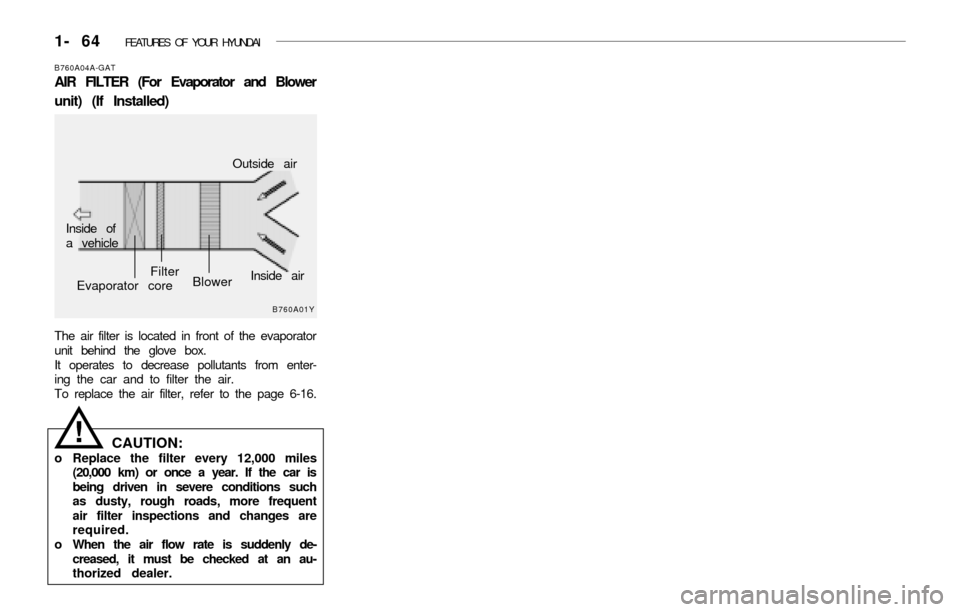
1- 64 FEATURES OF YOUR HYUNDAI
!
B760A01Y
The air filter is located in front of the evaporator
unit behind the glove box.
It operates to decrease pollutants from enter-
ing the car and to filter the air.
To replace the air filter, refer to the page 6-16.
B760A04A-GAT
AIR FILTER (For Evaporator and Blower
unit) (If Installed)
Inside of
a vehicle
Evaporator coreFilter
Blower
Outside air
CAUTION:o Replace the filter every 12,000 miles
(20,000 km) or once a year. If the car is
being driven in severe conditions such
as dusty, rough roads, more frequent
air filter inspections and changes are
required.
o When the air flow rate is suddenly de-
creased, it must be checked at an au-
thorized dealer.Inside air
Page 78 of 186
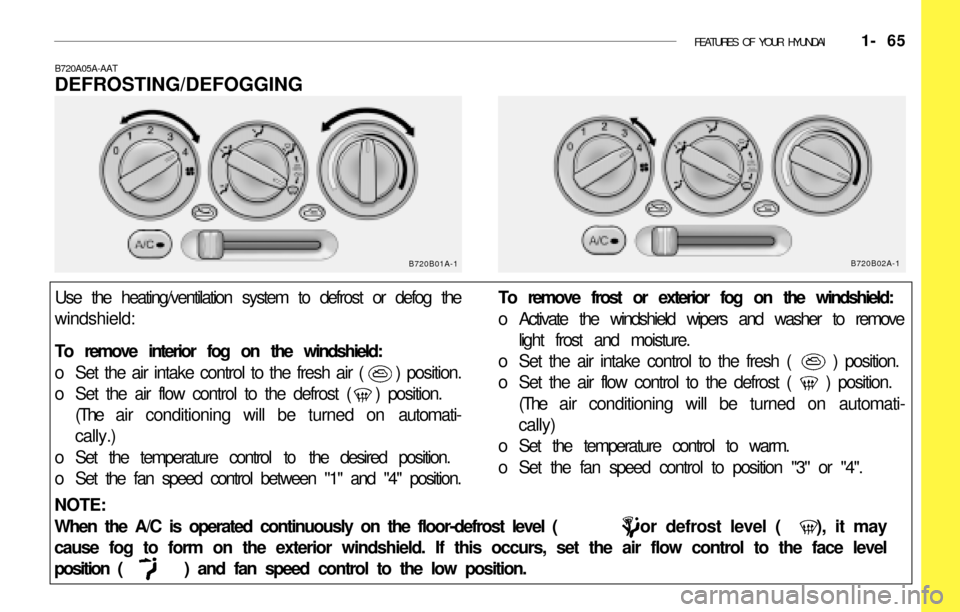
FEATURES OF YOUR HYUNDAI 1- 65
NOTE:
When the A/C is operated continuously on the floor-defrost level ( ) or defrost level ( ), it may
cause fog to form on the exterior windshield. If this occurs, set the air flow control to the face level
position ( ) and fan speed control to the low position. Use the heating/ventilation system to defrost or defog the
windshield:
To remove interior fog on the windshield:
o Set the air intake control to the fresh air ( ) position.
o Set the air flow control to the defrost ( ) position.
(The air conditioning will be turned on automati-
cally.)
o Set the temperature control to the desired position.
o Set the fan speed control between "1" and "4" position.To remove frost or exterior fog on the windshield:
o Activate the windshield wipers and washer to remove
light frost and moisture.
o Set the air intake control to the fresh ( ) position.
o Set the air flow control to the defrost ( ) position.
(The air conditioning will be turned on automati-
cally)
o Set the temperature control to warm.
o Set the fan speed control to position "3" or "4".
B720A05A-AAT
DEFROSTING/DEFOGGING
B720B01A-1B720B02A-1
Page 79 of 186

1- 66 FEATURES OF YOUR HYUNDAI
FM broadcasts are transmitted at high fre-
quencies and do not bend to follow the earth's
surface. Because of this, FM broadcasts gen-
erally begin to fade at short distances from the
station. Also, FM signals are easily affected by
buildings, mountains, or other obstructions.
These can result in certain listening conditions
which might lead you to believe a problem
exists with your radio. The following conditions
are normal and do not indicate radio trouble: AM broadcasts can be received at greater dis-
tances than FM broadcasts. This is because
AM radio waves are transmitted at low fre-
quencies. These long, low frequency radio
waves can follow the curvature of the earth
rather than travelling straight out into the atmo-
sphere. In addition, they curve around ob-
structions so that they can provide better
signal coverage.
B750A02A-AAT
STEREO SOUND SYSTEM
How Car Audio Works
AM and FM radio signals are broadcast from
transmitter towers located around your city. They
are intercepted by the radio antenna on your
car. This signal is then received by the radio and
sent to your car speakers.
When a strong radio signal has reached your
vehicle, the precise engineering of your audio
system ensures high quality reproduction. How-
ever, in some cases the signal coming to your
vehicle may not be strong and clear. This can
be due to factors such as the distance from
the radio station, closeness of other strong
radio stations or the presence of buildings,
bridges or other large obstructions in the area.Ionosphere
B750A02L
Mountains
Buildings
Obstructed areaUnobstructed
area FM radio station
B750A03L
Ionosphere FM reception
B750A01L
Iron bridges
AM reception
Page 80 of 186
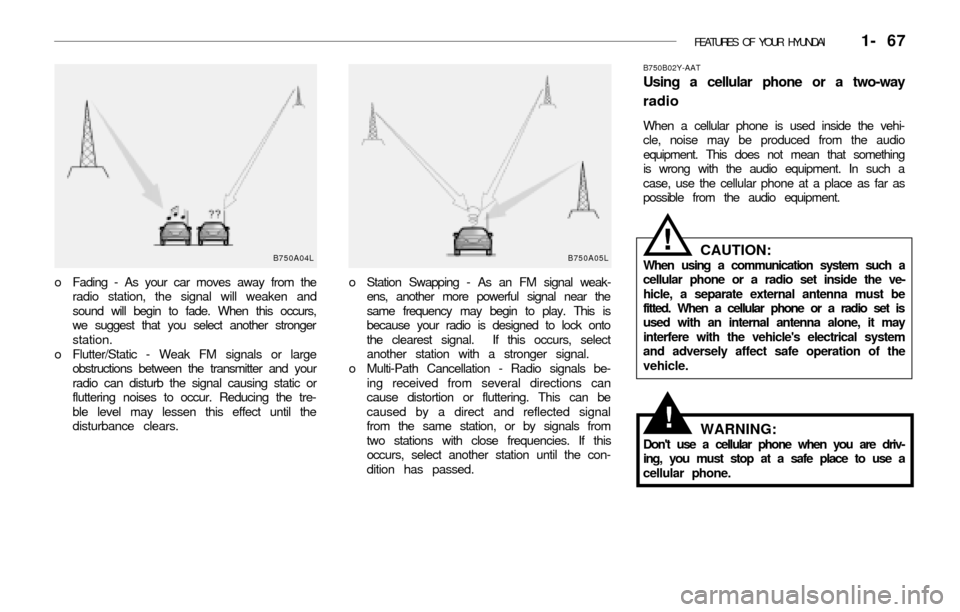
FEATURES OF YOUR HYUNDAI 1- 67
o Station Swapping - As an FM signal weak-
ens, another more powerful signal near the
same frequency may begin to play. This is
because your radio is designed to lock onto
the clearest signal. If this occurs, select
another station with a stronger signal.
o Multi-Path Cancellation - Radio signals be-
ing received from several directions can
cause distortion or fluttering. This can be
caused by a direct and reflected signal
from the same station, or by signals from
two stations with close frequencies. If this
occurs, select another station until the con-
dition has passed.
B750B02Y-AAT
Using a cellular phone or a two-way
radio
When a cellular phone is used inside the vehi-
cle, noise may be produced from the audio
equipment. This does not mean that something
is wrong with the audio equipment. In such a
case, use the cellular phone at a place as far as
possible from the audio equipment.
o Fading - As your car moves away from the
radio station, the signal will weaken and
sound will begin to fade. When this occurs,
we suggest that you select another stronger
station.
o Flutter/Static - Weak FM signals or large
obstructions between the transmitter and your
radio can disturb the signal causing static or
fluttering noises to occur. Reducing the tre-
ble level may lessen this effect until the
disturbance clears.
B750A04L B750A05LCAUTION:When using a communication system such a
cellular phone or a radio set inside the ve-
hicle, a separate external antenna must be
fitted. When a cellular phone or a radio set is
used with an internal antenna alone, it may
interfere with the vehicle's electrical system
and adversely affect safe operation of the
vehicle.
WARNING:Don't use a cellular phone when you are driv-
ing, you must stop at a safe place to use a
cellular phone.
!
!